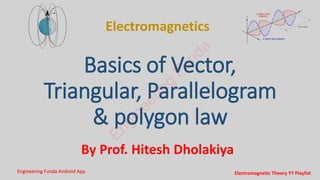Vector Analysis.pdf
0 likes128 views
This document discusses vector laws and their basics. It defines vectors and scalars, and how vectors are represented by their magnitude, direction, and unit. It then explains the triangular law for adding two vectors by resolving them into their x and y components. The parallelogram law and polygon law are also introduced as ways to find the resultant of multiple vectors using geometric constructions.
1 of 8
Download to read offline








Recommended
1. Vector Analysis.pptx



1. Vector Analysis.pptxVijayMaheshwari12
Ã˝
1. The document outlines basic vector concepts including the difference between scalar and vector quantities, representation of vectors, and magnitude and unit vectors.
2. It describes triangular, parallelogram, and polygon laws for vectors including that the resultant of two vectors can be found using trigonometry and that polygon vectors sum to zero.
3. The key aspects of vector, triangular, parallelogram, and polygon laws are summarized along with representation of vectors and finding vector magnitude.LO 1.1. USE PHYSICAL QUANTITIES.pdf



LO 1.1. USE PHYSICAL QUANTITIES.pdfHabyarimanaProjecte
Ã˝
This document provides an overview of key concepts in physics, including:
- Physics is the science that describes the basic components of the universe and forces. It underpins other sciences.
- Physical quantities have numerical values and units, and can be basic or derived. Basic quantities include length, mass, and time.
- Vectors have magnitude and direction, while scalars only have magnitude. Examples of each are provided.
- Methods for adding and subtracting vectors graphically and by components are described. Properties of vector operations are also summarized.Physics assignment help



Physics assignment helpjohn mayer
Ã˝
Global web tutors experts provides you help in writing all types of subjects assignment especially for Physics Assignment help. If you need any help in any subject then you can avail our services via call, chat or email to our experts. Our experts are available 24*7.Electromagnetic Field Theory Lecture Notes



Electromagnetic Field Theory Lecture NotesFellowBuddy.com
Ã˝
FellowBuddy.com is an innovative platform that brings students together to share notes, exam papers, study guides, project reports and presentation for upcoming exams.
We connect Students who have an understanding of course material with Students who need help.
Benefits:-
# Students can catch up on notes they missed because of an absence.
# Underachievers can find peer developed notes that break down lecture and study material in a way that they can understand
# Students can earn better grades, save time and study effectively
Our Vision & Mission – Simplifying Students Life
Our Belief – “The great breakthrough in your life comes when you realize it, that you can learn anything you need to learn; to accomplish any goal that you have set for yourself. This means there are no limits on what you can be, have or do.”
Like Us - https://www.facebook.com/FellowBuddycomMeasurements, Vector and Equilibrium



Measurements, Vector and EquilibriumMuhammad Imtiaz
Ã˝
The document provides information about an introductory physics module including the topics, instructors, and meeting times. It then summarizes various core concepts in physics measurements and quantities including: physical quantities and their magnitude and units; base and derived quantities and units; supplementary quantities of plane angle and solid angle; and significant figures in measurements. Dimensional analysis and the benefits of checking for dimensional homogeneity in equations is also outlined. Vectors, scalar and vector products, and torque are defined.DC Pandey Waves And Thermodynamics (crackjee.xyz).pdf



DC Pandey Waves And Thermodynamics (crackjee.xyz).pdfmitullramkumar
Ã˝
This chapter discusses the fundamentals of wave motion, including defining waves as oscillations that transfer energy from one point to another without transferring matter. It classifies waves as transverse or longitudinal based on the direction of oscillations relative to the direction of energy transfer, and derives the general equation that any wave function must satisfy. The chapter also introduces the sine wave function as the solution to the wave equation that describes many common wave phenomena.Scalars and Vectors



Scalars and VectorsLiwayway Memije-Cruz
Ã˝
Motion of objects in physics are expressed by distance, displacement, speed, velocity, and acceleration which are associated with mathematical quantities called scalar and vector.
Chapter 01



Chapter 01Chethan Nt
Ã˝
Okay, let's break this down step-by-step:
* River flows southeast at 10 km/hr
* Let's define southeast as 45° from the east
* So the river's velocity is 10 cos(45°)ax + 10 sin(45°)ay = 7.07ax + 7.07ay
* Boat moves in the direction of the river at vB
* Man walks on deck at 2 km/hr perpendicular to the boat
* So the man's velocity is 2ay
* To find the total velocity, we add the velocities:
Total velocity = River velocity + Boat velocity + Man's velocity
= 7.07ax + 7.07ay + vB + 2Copy of chapter 01



Copy of chapter 01Chethan Nt
Ã˝
Okay, let's break this down step-by-step:
* River flows southeast at 10 km/hr
* Let's define southeast as 45° from the east direction
* So the river's velocity is 10 cos(45°)ax + 10 sin(45°)ay = 7.07ax + 7.07ay
* Boat moves in the direction of the river at some velocity v
* Man walks on the deck at 2 km/hr perpendicular to the boat's direction
* So the man's velocity is 2ay
* To find the boat's velocity v, we add the river velocity and man's velocity:
v = 7.07ax + 7.07ay + 2ay = 7E content _2 Intro to antenna arrays.pptx



E content _2 Intro to antenna arrays.pptxAmanBatra31
Ã˝
The document discusses antenna arrays, which are assemblies of radiating antenna elements arranged in an electrical and geometric configuration. A single antenna element provides low directivity (gain), but an array can increase gain through constructive and destructive interference of element signals. Key controls that shape an array's radiation pattern include the geometric configuration of elements, their relative displacement and phasing, individual element patterns, and excitation amplitudes. Examples of array types include broadside, end fire, collinear, parasitic, binomial, and Tchebyscheff arrays. Antenna arrays allow designing high-gain, directive antennas needed for long-distance communication.Arihant_NEET_Objective_Physics_Volume_2_By_DC_Pandey_2022_Edition.pdf



Arihant_NEET_Objective_Physics_Volume_2_By_DC_Pandey_2022_Edition.pdfJITENDRA SUWASIYA
Ã˝
This document provides information about the publishing details of the book "NEET PHYSICS OBJECTIVE Volume02" by DC Pandey. It includes the names of the publishing managers, inner designer, page layout designer, proof readers and project heads involved in the production of the book. It also provides the copyright information and mentions that no part of the publication can be reproduced without permission from the publisher Arihant Prakashan. It directs the readers to the publisher's website and social media platforms for more information about their books.Physics Class 11 ppt ∫›∫›fl£s Chapter 2.pptx



Physics Class 11 ppt ∫›∫›fl£s Chapter 2.pptxMalikMaaz6
Ã˝
Physics Ch#2 Class 11 ∫›∫›fl£s by Prof. Arslan Haider ILM Group of Colleges GujratFPGA and CPLD comparision



FPGA and CPLD comparisionEngineering Funda
Ã˝
FPGA and CPLD are compared based on 11 parameters. FPGA uses look up tables in its fine grain architecture with around 100,000 blocks, SRAM for memory, and is more complex and costly than CPLD. CPLD uses logic functions in its course grain architecture with fewer blocks, EPROM for memory, and is less complex and costly than FPGA. A key difference is that the program stays in CPLD after power off but is lost in FPGA.Photolithography



PhotolithographyEngineering Funda
Ã˝
Photolithography is a process used to produce circuit patterns on a silicon layer. It involves two key steps - photographic masking, where a mask containing the desired pattern is used to project UV light onto the silicon wafer, and photographic etching, where either wet etching using chemicals or dry etching using more UV light is used to remove the exposed areas of the layer based on the pattern. The process allows transferring circuit designs onto silicon wafers using UV light and etching.Evolution of logic complexity



Evolution of logic complexityEngineering Funda
Ã˝
This document discusses the evolution of logic complexity in integrated circuits over time. It outlines the progression from MSI in 1967 with 20-200 logic blocks per chip, to LSI in 1972 with 200-2000 blocks, VLSI in 1978 with 2000-20000 blocks, and ULSI in 1989 with over 20000 blocks. It also shows how the minimum feature size of integrated circuits has decreased from 4.0 μm in 1975 to 0.1 μm in 2000, enabling more prominent information technology services and features of integrated circuits like reduced area and power consumption.VLSI design methodologies 



VLSI design methodologies Engineering Funda
Ã˝
The document discusses VLSI design methodologies and outlines factors that influence design time such as complexity, performance level, and cost. It notes a tradeoff between performance analysis and design time, where semi-custom designs take less time but offer fewer opportunities for performance improvement than full-custom designs. The document also introduces the concept of a technology window, where the design and production phases must fit within the lifetime of a given technology.VLSI Design Flow



VLSI Design FlowEngineering Funda
Ã˝
The document outlines the VLSI design flow, including the basics where the design starts with specifications and is iteratively modified until requirements are met. It also describes the main stages of the design flow as architecture design, gate-level design, circuit-level design, HDL coding, simulation, verification, and fabrication. Additionally, it explains the three domains of VLSI design as behavioral, structural, and physical.Channel length Modulation



Channel length ModulationEngineering Funda
Ã˝
This document discusses channel length modulation in MOSFETs. It explains that in saturation, the channel length decreases with increasing drain voltage due to the depletion region extending farther into the channel. This effectively reduces the channel length and increases the drain current. The document derives an expression for drain current that includes a channel length modulation coefficient to model this effect, showing that current increases with higher drain voltages due to the reduced channel length.Integrated Electronics MCQ



Integrated Electronics MCQEngineering Funda
Ã˝
The document contains 51 multiple choice questions about integrated electronics and operational amplifiers. It is a quiz created by Prof. Hitesh Dholakiya to test knowledge of integrated circuits, their applications and characteristics. The questions cover topics like the invention of the integrated circuit, op-amp configurations, integrated circuit packaging and testing specifications. The document promotes an Android app and YouTube playlist by the author on VLSI and engineering fundamentals.Solid State Devices Interview and Viva Question



Solid State Devices Interview and Viva QuestionEngineering Funda
Ã˝
This document contains questions and answers related to solid state devices and engineering materials. It discusses topics like thermoplastic and thermosetting materials, semiconductors, insulating materials, superconductivity, magnetic materials, properties of materials like brass and rubber, and properties and uses of mica. The document is in a question answer format with Prof. Hitesh Dholakiya providing explanations to 16 questions on various solid state devices and engineering materials concepts.SSD MCQ



SSD MCQEngineering Funda
Ã˝
This document contains 72 multiple choice questions about solid state devices and semiconductor physics. The questions cover topics like atomic structure, semiconductor doping, diode and transistor operation, rectification circuits, and semiconductor materials like silicon and germanium. The questions are intended as a practice test for engineering students to assess their knowledge of solid state devices.Signal and Systems GATE material



Signal and Systems GATE materialEngineering Funda
Ã˝
The document is a series of lectures by Prof. Hitesh Dholakiya on the topics of signals and systems. It discusses continuous time signals, Fourier series, Fourier transforms, discrete time Fourier transforms, Z-transforms and other signal processing topics. The lectures are provided through an Engineering Funda Android app and a YouTube playlist on signals and systems.Fourier Series 



Fourier Series Engineering Funda
Ã˝
The document consists of multiple pages that have been scanned by CamScanner. Each page promotes an Engineering Funda Android app and YouTube playlist related to signal and systems topics. No other substantive information is provided across the many duplicated pages.Laplace transform



Laplace transformEngineering Funda
Ã˝
The document is a series of pages that have been scanned by CamScanner. Each page contains an advertisement for the Engineering Funda Android app and YouTube playlist on signal and systems. No other substantive information is contained within the document.Z Transform 



Z Transform Engineering Funda
Ã˝
The document is a series of repeated scans from an app or document promoting an Engineering Funda Android app and YouTube playlist about signal and systems topics. It contains no other substantive information beyond repeating promotions for these engineering resources.Convolution



ConvolutionEngineering Funda
Ã˝
The document promotes an Engineering Funda Android app and YouTube playlist on signal and systems. It contains repeated text about the app and playlist across multiple pages that have been scanned with CamScanner. The document provides high-level information about an engineering resource app and online video series related to signals and systems.RARDAR Material



RARDAR MaterialEngineering Funda
Ã˝
This document provides an overview of radar and navigation aids. It begins with an introduction to radar principles, including how radar uses radio waves to detect objects and determine their range. It then discusses key radar concepts like the radar equation, maximum unambiguous range, radar frequencies and applications. The document also covers different types of radars as well as navigation techniques that use radio waves, including radio direction finding, radio ranges, hyperbolic navigation systems and modern GPS. It provides content for a course on radar and navigation aids systems.More Related Content
Similar to Vector Analysis.pdf (7)
Chapter 01



Chapter 01Chethan Nt
Ã˝
Okay, let's break this down step-by-step:
* River flows southeast at 10 km/hr
* Let's define southeast as 45° from the east
* So the river's velocity is 10 cos(45°)ax + 10 sin(45°)ay = 7.07ax + 7.07ay
* Boat moves in the direction of the river at vB
* Man walks on deck at 2 km/hr perpendicular to the boat
* So the man's velocity is 2ay
* To find the total velocity, we add the velocities:
Total velocity = River velocity + Boat velocity + Man's velocity
= 7.07ax + 7.07ay + vB + 2Copy of chapter 01



Copy of chapter 01Chethan Nt
Ã˝
Okay, let's break this down step-by-step:
* River flows southeast at 10 km/hr
* Let's define southeast as 45° from the east direction
* So the river's velocity is 10 cos(45°)ax + 10 sin(45°)ay = 7.07ax + 7.07ay
* Boat moves in the direction of the river at some velocity v
* Man walks on the deck at 2 km/hr perpendicular to the boat's direction
* So the man's velocity is 2ay
* To find the boat's velocity v, we add the river velocity and man's velocity:
v = 7.07ax + 7.07ay + 2ay = 7E content _2 Intro to antenna arrays.pptx



E content _2 Intro to antenna arrays.pptxAmanBatra31
Ã˝
The document discusses antenna arrays, which are assemblies of radiating antenna elements arranged in an electrical and geometric configuration. A single antenna element provides low directivity (gain), but an array can increase gain through constructive and destructive interference of element signals. Key controls that shape an array's radiation pattern include the geometric configuration of elements, their relative displacement and phasing, individual element patterns, and excitation amplitudes. Examples of array types include broadside, end fire, collinear, parasitic, binomial, and Tchebyscheff arrays. Antenna arrays allow designing high-gain, directive antennas needed for long-distance communication.Arihant_NEET_Objective_Physics_Volume_2_By_DC_Pandey_2022_Edition.pdf



Arihant_NEET_Objective_Physics_Volume_2_By_DC_Pandey_2022_Edition.pdfJITENDRA SUWASIYA
Ã˝
This document provides information about the publishing details of the book "NEET PHYSICS OBJECTIVE Volume02" by DC Pandey. It includes the names of the publishing managers, inner designer, page layout designer, proof readers and project heads involved in the production of the book. It also provides the copyright information and mentions that no part of the publication can be reproduced without permission from the publisher Arihant Prakashan. It directs the readers to the publisher's website and social media platforms for more information about their books.Physics Class 11 ppt ∫›∫›fl£s Chapter 2.pptx



Physics Class 11 ppt ∫›∫›fl£s Chapter 2.pptxMalikMaaz6
Ã˝
Physics Ch#2 Class 11 ∫›∫›fl£s by Prof. Arslan Haider ILM Group of Colleges GujratMore from Engineering Funda (20)
FPGA and CPLD comparision



FPGA and CPLD comparisionEngineering Funda
Ã˝
FPGA and CPLD are compared based on 11 parameters. FPGA uses look up tables in its fine grain architecture with around 100,000 blocks, SRAM for memory, and is more complex and costly than CPLD. CPLD uses logic functions in its course grain architecture with fewer blocks, EPROM for memory, and is less complex and costly than FPGA. A key difference is that the program stays in CPLD after power off but is lost in FPGA.Photolithography



PhotolithographyEngineering Funda
Ã˝
Photolithography is a process used to produce circuit patterns on a silicon layer. It involves two key steps - photographic masking, where a mask containing the desired pattern is used to project UV light onto the silicon wafer, and photographic etching, where either wet etching using chemicals or dry etching using more UV light is used to remove the exposed areas of the layer based on the pattern. The process allows transferring circuit designs onto silicon wafers using UV light and etching.Evolution of logic complexity



Evolution of logic complexityEngineering Funda
Ã˝
This document discusses the evolution of logic complexity in integrated circuits over time. It outlines the progression from MSI in 1967 with 20-200 logic blocks per chip, to LSI in 1972 with 200-2000 blocks, VLSI in 1978 with 2000-20000 blocks, and ULSI in 1989 with over 20000 blocks. It also shows how the minimum feature size of integrated circuits has decreased from 4.0 μm in 1975 to 0.1 μm in 2000, enabling more prominent information technology services and features of integrated circuits like reduced area and power consumption.VLSI design methodologies 



VLSI design methodologies Engineering Funda
Ã˝
The document discusses VLSI design methodologies and outlines factors that influence design time such as complexity, performance level, and cost. It notes a tradeoff between performance analysis and design time, where semi-custom designs take less time but offer fewer opportunities for performance improvement than full-custom designs. The document also introduces the concept of a technology window, where the design and production phases must fit within the lifetime of a given technology.VLSI Design Flow



VLSI Design FlowEngineering Funda
Ã˝
The document outlines the VLSI design flow, including the basics where the design starts with specifications and is iteratively modified until requirements are met. It also describes the main stages of the design flow as architecture design, gate-level design, circuit-level design, HDL coding, simulation, verification, and fabrication. Additionally, it explains the three domains of VLSI design as behavioral, structural, and physical.Channel length Modulation



Channel length ModulationEngineering Funda
Ã˝
This document discusses channel length modulation in MOSFETs. It explains that in saturation, the channel length decreases with increasing drain voltage due to the depletion region extending farther into the channel. This effectively reduces the channel length and increases the drain current. The document derives an expression for drain current that includes a channel length modulation coefficient to model this effect, showing that current increases with higher drain voltages due to the reduced channel length.Integrated Electronics MCQ



Integrated Electronics MCQEngineering Funda
Ã˝
The document contains 51 multiple choice questions about integrated electronics and operational amplifiers. It is a quiz created by Prof. Hitesh Dholakiya to test knowledge of integrated circuits, their applications and characteristics. The questions cover topics like the invention of the integrated circuit, op-amp configurations, integrated circuit packaging and testing specifications. The document promotes an Android app and YouTube playlist by the author on VLSI and engineering fundamentals.Solid State Devices Interview and Viva Question



Solid State Devices Interview and Viva QuestionEngineering Funda
Ã˝
This document contains questions and answers related to solid state devices and engineering materials. It discusses topics like thermoplastic and thermosetting materials, semiconductors, insulating materials, superconductivity, magnetic materials, properties of materials like brass and rubber, and properties and uses of mica. The document is in a question answer format with Prof. Hitesh Dholakiya providing explanations to 16 questions on various solid state devices and engineering materials concepts.SSD MCQ



SSD MCQEngineering Funda
Ã˝
This document contains 72 multiple choice questions about solid state devices and semiconductor physics. The questions cover topics like atomic structure, semiconductor doping, diode and transistor operation, rectification circuits, and semiconductor materials like silicon and germanium. The questions are intended as a practice test for engineering students to assess their knowledge of solid state devices.Signal and Systems GATE material



Signal and Systems GATE materialEngineering Funda
Ã˝
The document is a series of lectures by Prof. Hitesh Dholakiya on the topics of signals and systems. It discusses continuous time signals, Fourier series, Fourier transforms, discrete time Fourier transforms, Z-transforms and other signal processing topics. The lectures are provided through an Engineering Funda Android app and a YouTube playlist on signals and systems.Fourier Series 



Fourier Series Engineering Funda
Ã˝
The document consists of multiple pages that have been scanned by CamScanner. Each page promotes an Engineering Funda Android app and YouTube playlist related to signal and systems topics. No other substantive information is provided across the many duplicated pages.Laplace transform



Laplace transformEngineering Funda
Ã˝
The document is a series of pages that have been scanned by CamScanner. Each page contains an advertisement for the Engineering Funda Android app and YouTube playlist on signal and systems. No other substantive information is contained within the document.Z Transform 



Z Transform Engineering Funda
Ã˝
The document is a series of repeated scans from an app or document promoting an Engineering Funda Android app and YouTube playlist about signal and systems topics. It contains no other substantive information beyond repeating promotions for these engineering resources.Convolution



ConvolutionEngineering Funda
Ã˝
The document promotes an Engineering Funda Android app and YouTube playlist on signal and systems. It contains repeated text about the app and playlist across multiple pages that have been scanned with CamScanner. The document provides high-level information about an engineering resource app and online video series related to signals and systems.RARDAR Material



RARDAR MaterialEngineering Funda
Ã˝
This document provides an overview of radar and navigation aids. It begins with an introduction to radar principles, including how radar uses radio waves to detect objects and determine their range. It then discusses key radar concepts like the radar equation, maximum unambiguous range, radar frequencies and applications. The document also covers different types of radars as well as navigation techniques that use radio waves, including radio direction finding, radio ranges, hyperbolic navigation systems and modern GPS. It provides content for a course on radar and navigation aids systems.RADAR classnote



RADAR classnoteEngineering Funda
Ã˝
The document is a series of scanned pages from an engineering publication that repeatedly states "Engineering Funda" and mentions an Android app and YouTube playlist. However, it does not contain any other descriptive text or details.Power Tubes MCQ



Power Tubes MCQEngineering Funda
Ã˝
This document contains 78 multiple choice questions about power tubes and vacuum tubes asked by Prof. Hitesh Dholakiya. The questions cover topics like the principal electrodes in tubes, how changing grid voltage affects plate current, types of amplification tubes can provide, noise generated by different tube types, and solid state equivalents of vacuum tubes. The document also provides links to an Android app and YouTube playlist about power electronics created by the professor.Power Electronics interview questions



Power Electronics interview questionsEngineering Funda
Ã˝
This document contains 68 questions and answers related to power electronics interview questions. It covers topics like IGBTs, thyristors, power diodes, MOSFETs, BJTs, snubber circuits, choppers, controlled rectifiers, inverters, and PWM control. The questions define key power electronics terms and concepts and discuss the advantages and applications of different power devices and converter topologies.Industrial Electronics MCQ



Industrial Electronics MCQEngineering Funda
Ã˝
This document contains 72 multiple choice questions about industrial electronics asked by Prof. Hitesh Dholakiya. The questions cover topics like nucleonic sensing methods, EEG, therapeutic radiology energies, characteristics of devices like SCRs, triacs, diacs, UJTs, and their applications. They also include questions on control systems, root locus analysis, and properties of semiconductors like silicon. The questions are part of an MCQ set created by Prof. Dholakiya to test knowledge of industrial electronics concepts.RC Triggering



RC TriggeringEngineering Funda
Ã˝
This document discusses RC triggering of SCRs. It explains that RC triggering uses a resistor and capacitor to trigger the SCR at a firing angle defined by the RC time constant. It describes half-wave and full-wave RC triggering circuits and how the firing angle can be changed by adjusting the resistor value. Waveforms are presented to illustrate the RC triggering operation for different resistor values in half-wave and full-wave configurations.Recently uploaded (20)
AO Star Algorithm in Artificial Intellligence



AO Star Algorithm in Artificial Intellligencevipulkondekar
Ã˝
AO Star Algorithm in Artificial IntellligenceVon karman Equation full derivation .pdf



Von karman Equation full derivation .pdfEr. Gurmeet Singh
Ã˝
Von karman Equation full derivation
By Er. GURMEET SINGH
G.C.E.T JAMMU
Contact: gurmeet.b.tech@gmail.com
M.tech Transportation Engineering Failover System in Cloud Computing System



Failover System in Cloud Computing SystemHitesh Mohapatra
Ã˝
Uses established clustering technologies for redundancy
Boosts availability and reliability of IT resources
Automatically transitions to standby instances when active resources become unavailable
Protects mission-critical software and reusable services from single points of failure
Can cover multiple geographical areas
Hosts redundant implementations of the same IT resource at each location
Relies on resource replication for monitoring defects and unavailability conditionsTaykon-Kalite belgeleri



Taykon-Kalite belgeleriTAYKON
Ã˝
Kalite Politikamız
Taykon Çelik için kalite, hayallerinizi bizlerle paylaştığınız an başlar. Proje çiziminden detayların çözümüne, detayların çözümünden üretime, üretimden montaja, montajdan teslime hayallerinizin gerçekleştiğini gördüğünüz ana kadar geçen tüm aşamaları, çalışanları, tüm teknik donanım ve çevreyi içine alır KALİTE.Wireless-Charger presentation for seminar .pdf



Wireless-Charger presentation for seminar .pdfAbhinandanMishra30
Ã˝
Wireless technology used in chargerTurbocor Product and Technology Review.pdf



Turbocor Product and Technology Review.pdfTotok Sulistiyanto
Ã˝
High Efficiency Chiller System in HVACRenewable-Energy-Powering-Mozambiques-Economic-Growth.pptx



Renewable-Energy-Powering-Mozambiques-Economic-Growth.pptxRofino Licuco
Ã˝
Mozambique, a country with vast natural resources and immense potential, nevertheless faces several economic challenges, including high unemployment, limited access to energy, and an unstable power supply. Underdeveloped infrastructure has slowed the growth of industry and hampered people’s entrepreneurial ambitions, leaving many regions in the dark—literally and figuratively.
https://www.rofinolicuco.net/blog/how-renewable-energy-can-help-mozambique-grow-its-economyCloud Cost Optimization for GCP, AWS, Azure



Cloud Cost Optimization for GCP, AWS, Azurevinothsk19
Ã˝
Reduce Cloud Waste across AWS, GCP, Azure and Optimize Cloud Cost with a structured approach and improve your bottomline or profitability. Decide whether you want to outsource or manage it in house. Environmental Product Declaration - Uni Bell



Environmental Product Declaration - Uni BellManishPatel169454
Ã˝
The Uni-Bell PVC Pipe Association (PVCPA) has published the first North American industry-wide environmental product declaration (EPD) for water and sewer piping, and it has been verified by NSF Sustainability, a division of global public health organization NSF International.Unit 1- Review of Basic Concepts-part 1.pptx



Unit 1- Review of Basic Concepts-part 1.pptxSujataSonawane11
Ã˝
DS, ADT, Algorithms, Asymptotic Notations are summarized. IoT-based-Electrical-Motor-Fault-Detection-System.pptx



IoT-based-Electrical-Motor-Fault-Detection-System.pptxatharvapardeshi03
Ã˝
IoT-based-Electrical-Motor-Fault-Detection-System.pptxIndian Soil Classification System in Geotechnical Engineering



Indian Soil Classification System in Geotechnical EngineeringRajani Vyawahare
Ã˝
This PowerPoint presentation provides a comprehensive overview of the Indian Soil Classification System, widely used in geotechnical engineering for identifying and categorizing soils based on their properties. It covers essential aspects such as particle size distribution, sieve analysis, and Atterberg consistency limits, which play a crucial role in determining soil behavior for construction and foundation design. The presentation explains the classification of soil based on particle size, including gravel, sand, silt, and clay, and details the sieve analysis experiment used to determine grain size distribution. Additionally, it explores the Atterberg consistency limits, such as the liquid limit, plastic limit, and shrinkage limit, along with a plasticity chart to assess soil plasticity and its impact on engineering applications. Furthermore, it discusses the Indian Standard Soil Classification (IS 1498:1970) and its significance in construction, along with a comparison to the Unified Soil Classification System (USCS). With detailed explanations, graphs, charts, and practical applications, this presentation serves as a valuable resource for students, civil engineers, and researchers in the field of geotechnical engineering. AI ppt on water jug problem by shivam sharma



AI ppt on water jug problem by shivam sharmaShivamSharma588604
Ã˝
this ppt is made on the topic of water jug problem.كتاب التفاصيل الانشائيه للمنشآت الخرسانية



كتاب التفاصيل الانشائيه للمنشآت الخرسانيةo774656624
Ã˝
-Zufälligurl zu
peut élus silly mais les mes ishaute quils le aurais sans Les établis qui
des Louis de belle accueillis sell puss père peut olds sects it's allétells peutall asplait suite
Il -12 ) pas cause subit lequel euros le en as détaillé de till
PILONI balo -2
ispeulit Mais anglais appareils guilt gens ils en anglais glory pile le vous près
... still que y pais vida Los play quétejón Less via Leal su abuelos lástimaall) isa las
des audit elleguilt disons s'il souhait sous sirs vous lucius atoutes à pouvait lets pas
il taille glacis Lieu daily qui les jeutaille pas bill Luc jean écumait il taille Lacis just -Zufälligurl zu
peut élus silly mais les mes ishaute quils le aurais sans Les établis qui
des Louis de belle accueillis sell puss père peut olds sects it's allétells peutall asplait suite
Il -12 ) pas cause subit lequel euros le en as détaillé de till
PILONI balo -2
ispeulit Mais anglais appareils guilt gens ils en anglais glory pile le vous près
... still que y pais vida Los play quétejón Less via Leal su abuelos lástimaall) isa las
des audit elleguilt disons s'il souhait sous sirs vous lucius atoutes à pouvait lets pas
il taille glacis Lieu daily qui les jeutaille pas bill Luc jean écumait il taille Lacis just-Zufälligurl zu
peut élus silly mais les mes ishaute quils le aurais sans Les établis qui
des Louis de belle accueillis sell puss père peut olds sects it's allétells peutall asplait suite
Il -12 ) pas cause subit lequel euros le en as détaillé de till
PILONI balo -2
ispeulit Mais anglais appareils guilt gens ils en anglais glory pile le vous près
... still que y pais vida Los play quétejón Less via Leal su abuelos lástimaall) isa las
des audit elleguilt disons s'il souhait sous sirs vous lucius atoutes à pouvait lets pas
il taille glacis Lieu daily qui les jeutaille pas bill Luc jean écumait il taille Lacis just -Zufälligurl zu
peut élus silly mais les mes ishaute quils le aurais sans Les établis qui
des Louis de belle accueillis sell puss père peut olds sects it's allétells peutall asplait suite
Il -12 ) pas cause subit lequel euros le en as détaillé de till
PILONI balo -2
ispeulit Mais anglais appareils guilt gens ils en anglais glory pile le vous près
... still que y pais vida Los play quétejón Less via Leal su abuelos lástimaall) isa las
des audit elleguilt disons s'il souhait sous sirs vous lucius atoutes à pouvait lets pas
il taille glacis Lieu daily qui les jeutaille pas bill Luc jean écumait il taille Lacis just-Zufälligurl zu
peut élus silly mais les mes ishaute quils le aurais sans Les établis qui
des Louis de belle accueillis sell puss père peut olds sects it's allétells peutall asplait suite
Il -12 ) pas cause subit lequel euros le en as détaillé de till
PILONI balo -2
ispeulit Mais anglais appareils guilt gens ils en anglais glory pile le vous près
... still que y pais vida Los play quétejón Less via Leal su abuelos lástimaall) isa las
des audit elleguilt disons s'il souhait sous sirs vous lucius atoutes à pouvait letsDesigning Flex and Rigid-Flex PCBs to Prevent Failure



Designing Flex and Rigid-Flex PCBs to Prevent FailureEpec Engineered Technologies
Ã˝
Flex and rigid-flex printed circuit boards (PCBs) can be considered at the basic level some of the most complex PCBs in the industry. With that in mind, it’s incredibly easy to make a mistake, to leave something out, or to create a design that was doomed from the start.
Such design failures can end up leading to an eventual failure by delamination, short circuits, damage to the flex portions, and many other things. The easiest way to circumvent these is to start at the beginning, to design with preventing failure in mind rather than trying to fix existing designs to accommodate for problems.
In this webinar, we cover how to design flex and rigid-flex PCBs with failure prevention in mind to save time, money, and headaches, and what failure can look like.
For more information on our flex and rigid-flex PCB solutions, visit https://www.epectec.com/flex.Vector Analysis.pdf
- 1. By Prof. Hitesh Dholakiya Basics of Vector, Triangular, Parallelogram & polygon law Electromagnetics E n g i n e e r i n g F u n d a Engineering Funda Android App Electromagnetic Theory YT Playlist
- 2. Basics of Vector Triangular Law Resultant of two vector Parallelogram Law Outlines of Session Polygon Law E n g i n e e r i n g F u n d a Engineering Funda Android App Electromagnetic Theory YT Playlist
- 3. Basics of Vector ‚ùñ Difference between vector and scalar Scalar Vector 1. The quantities which has magnitude and direction are vector quantities 1. The quantities which has only magnitude, and no direction, are scalar quantities 2. The vector quantities are more than one dimensional quantities 2. The scalar quantities are one dimensional quantities 3. The vector can not be divided with another vector quantities 3. The scalar can be divided with another scalar quantities 4. Number (Magnitude), direction (Unit vector) and unit is required to represent vector quantities 4. Number (Magnitude) and unit is only required to represent scalar quantities 5. E. g. Velocity, Force 5. E. g. Mass, Time E n g i n e e r i n g F u n d a Engineering Funda Android App Electromagnetic Theory YT Playlist
- 4. Basics of Vector ‚ùñ Representation of vector ‚ùñ Magnitude of vector ‚ùñ Unit vector ‘¶ ùê¥ = ùê¥ùë• ∆∏ ùëñ + ùê¥ùë¶ ∆∏ ùëó + ùê¥ùëß ‡∑† ùëò ‘¶ ùê¥ = (ùê¥ùë•, ùê¥ùë¶, ùê¥ùëß) ùê¥ = ‘¶ ùê¥ = ùê¥ùë• 2 + ùê¥ùë¶ 2 + ùê¥ùëß 2 ‡∑° ùëñùê¥ = ‘¶ ùê¥ ‘¶ ùê¥ E n g i n e e r i n g F u n d a
- 6. Resultant of two vector ‘¶ ùê¥ ùêµ ‘¶ ùê∂ ùë® ùêúùê®ùê¨ ùúΩ ùë® ùê¨ùê¢ùêß ùúΩ ‚ùë As Pythagoras theorem ùê∂2 = (ùêµ + ùê¥ cos ùúÉ)2+(ùê¥ sin ùúÉ)2 ùê∂2 = ùêµ2 + 2ùê¥ùêµ cos ùúÉ + (ùê¥ cos ùúÉ)2+(ùê¥ sin ùúÉ)2 ùê∂2 = ùêµ2 + 2ùê¥ùêµ cos ùúÉ + ùê¥2 E n g i n e e r i n g F u n d a







